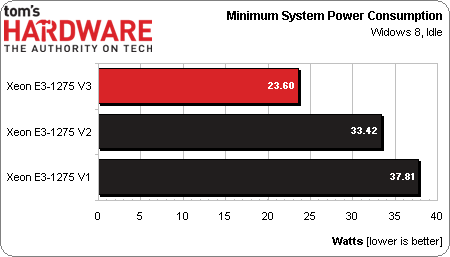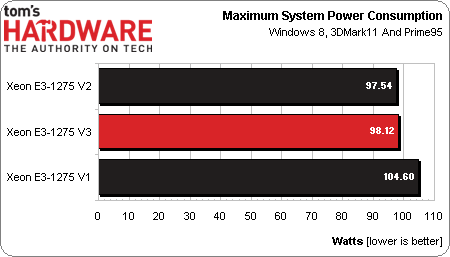Haswell-Based Xeon E3-1200: Three Generations, Benchmarked
Power Consumption And Noise
With each successive generation, from Sandy Bridge to Haswell, Intel made deliberate efforts to improve platform efficiency, measured in performance per watt. Ivy Bridge benefited from a transition to 22 nm manufacturing. Haswell incorporates some specific operating state improvements that help bring down idle power use, though we noticed on the desktop that efficiency isn't always significantly better. Those same trends carry over to our comparative look at Intel's Xeon E3-1275 across three generations.
At idle, the Haswell-based Xeon E3-1275 v3 idles at very low power. Like desktops, workstations spend a lot of their time doing little, making this an important measurement.
This chart was an interesting one to generate. In 3DMark 11, we were only seeing our samples pulling 60 W from the wall. The key is that both the CPU and GPU need taxing workloads thrown at them simultaneously in order to present a worst-case power figure.
Our noise figures are less a reflection of Intel's Xeon E3 and more an indication of how Supermicro is contending with the thermal load of each platform. To measure this, we took measurements at idle and under duress using both barebones configurations and all three CPUs.
Not surprisingly, the Sandy and Ivy Bridge-based configurations fall within a margin of error. They demonstrate similar power consumption characteristics and the rest of the supporting platform doesn't change. Haswell isn't much different, either.
What we can say, however, is that all three setups operate quietly. Because there are fans involved, they aren't silent. But they're certainly not boxes you'd need to keep in a server room. Supermicro clearly designed these things to behave in an office environment.
Summed up, these are low-power and low-noise workstation processors, unlike the Xeon E5s that trade some elegance for massive performance. The simple fact is that the GPU-enabled Intel Xeon E3 chips are designed to be used desk-side. As such, they'll take up more space than some of the denser server-oriented options out there. In datacenters, the technology improvements introduced alongside Ivy Bridge and the operating state advantages that accompany Haswell should prove very valuable. For example, I pay $20/ month for each amp in my colocation facility, so saving a few watts to stay within a lower power pricing tier can save me $240 each year. There are colocation providers that charge a bit less, and a lot more than what I pay. There are also many providers that increase charges for spikes above a pre-set threshold. In those cases, the latest Xeon E3s offer a very tangible benefit that might not be as apparent in the workstation world.
Get Tom's Hardware's best news and in-depth reviews, straight to your inbox.
Current page: Power Consumption And Noise
Prev Page Results: Media Encoding Next Page Xeon E3-1275 v3: A Lot Like Haswell On The Desktop, With Pro Features-
dgingeri I have two Dell T110 II servers, one with an E3-1230 and one with an E3-1220v2, that cost me less than $800 each. I can tell you, they are great little machines, perfect for self-teaching Windows Server or ESXi. I now have the E3-1220v2 set up as my Windows 2008r2 router/DNS/DHCP/file/print server, and it uses a mere 45W of power when idle. The E3-1230 is my ESXi 5.1 machine right now.Reply -
CommentariesAnd More Best article to say in your face to those who think Xeons are poor performers.Reply -
vmem honestly not surprising at allReply
I think 'meh' will be the overwhelming majority consensus on this chip -
g-unit1111 Reply11571644 said:honestly not surprising at all
I think 'meh' will be the overwhelming majority consensus on this chip
That's kind of the way I see it. I don't think the Xeon is anything to write home about like some people on this board do, but the average user and/or gamer won't notice a lick of difference between an i5, i7, and low end Xeon. I would only recommend them in instances of things like Photoshop and heavy duty CS5 usage, but even then an i7-4770K or i7-4820K would be a better choice. -
InvalidError While ARM chips may be doubling performance on a fairly regular basis, you need to keep in mind that ARM chips are starting from pretty far back. By the time they catch up with mainstream x86 chips, they will most likely hit very similar IPC and frequency scaling brick walls as x86 chips and won't gain much ground beyond that.Reply
The only real threat from ARM is to profit margins: once ARM catches up, it may become more difficult for Intel to maintain the large premiums they currently command across most markets. -
the1kingbob Did Toms looks at the AMD 6100, 6200, and 6300? That would make to be an interesting comparison since the underlying architecture changed from the 6200 to 6300 (i think, maybe 6100 to 6200)Reply -
Amdlova people in my county buy this processor for gaming... need a seriosly test on this. 1230v2 have same price 3570k here!Reply -
dgingeri "I would only recommend them in instances of things like Photoshop and heavy duty CS5 usage, but even then an i7-4770K or i7-4820K would be a better choice." They wouldn't be any advantage in either case. The advantage of the Xeon isn't performance, but stability. It's use of ECC memory makes it much better for purposes like a high end workstation for an engineer or digital artist so their work isn't lost or interrupted by a memory error and crash or in servers where it can stay running reliably for months at a time.Reply
In addition, the chipsets and platforms used with Xeons are more stringently held to industry standards, making them known quantities for device makers. Enterprise raid controllers are frequently unsupported on a standard desktop system with a Core i7 4770 and Z87 chipset, while they would be supported on a Xeon E3-1275v3 with a C226 chipset, even though the actual silicon design is exactly the same between the two.
There really isn't any difference in the silicon itself between a Haswell Core i7 and a Haswell Xeon E3, so there won't be a performance difference. The difference is in the stability of equipment surrounding each. -
pjkenned InvalidError - these are not in the same league as the ARM chips. Avoton and Rangeley are the real ARM competitor. I JUST got two Avoton 8-core platforms in the lab as this article was going live (benchmarks here: http://forums.servethehome.com/processors-motherboards/2444-intel-avoton-c2750-benchmarks-supermicro-a1sai-2750f.html ) If ARM was targeting Centerton (the Atom S1260), they are targeting a platform way behind Avoton and the E3 reviewed above.Reply
the1kingbob - I have AMD Opteron 3000, 4000 and 6000 series chips in the lab and use them daily. The Operton 3300 series would be the closest platform but the performance is significantly behind the Haswell Xeon E3-1275 V3. Those Opterons also do not have integrated GPUs like the E3-12x5 V1 V2 and V3 chips so are hard to compare. -
InvalidError Reply
And I never said they were - at least for now. But ARM might get there if they manage to sustain their current improvement pace for a few years while AMD and Intel remain stuck for most intents and purposes.11572444 said:InvalidError - these are not in the same league as the ARM chips.
Yes, Intel released some cut-down x86 chips to compete with ARM for low-power market segments but this is only a temporary fix since Intel will likely add much of that stuff back in to keep up with ARM as ARM performance ramps up. The interesting part in 3-5 years will be where ARM will go once they hit the same steep diminishing return slope AMD and Intel are on.


